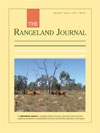RJ13092Virtual herding for flexible livestock management – a review
Twenty first century electronics offers exciting opportunities for the real-time management of free–ranging livestock. Once a proper stocking rate is determined livestock distribution remains the second biggest challenge when managing animal dominated landscapes. Virtual fencing promises to be a practical solution for managing animal distribution using a low-stress, flexible, pro-active real-time management approach that will optimize plant and animal productivity anywhere in the world.
RJ13092 Abstract | RJ13092 Full Text | RJ13092PDF (768 KB) Open Access Article




